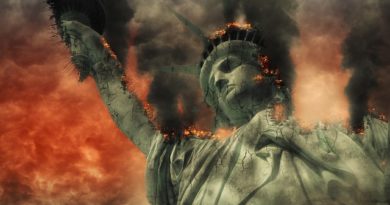The Divine Assembly
By Derek Gilbert
The ancient records are rife with references to pantheons that imitate the true Divine Assembly of our Lord and Savior. Baal, El, and El’s seventy sons are one example. Each pantheon is said to dwell upon a sacred mountain—whether natural or man-made (Babel being one such example). These precipitous and lofty throne rooms could be found across the globe, including Mount Zaphon (abode of Baal), Mount Olympus (home of the Olympians), and Mount Kailash (sacred to Shiva), to name but a few. But as we study the long spiritual war between Yahweh and the Fallen Realm, we find ourselves returning to Mount Hermon, the place where the Watchers descended and took an oath before cohabiting with human women and producing giant offspring—for it is also where El held court with his consort Asherah and his “seventy sons.”
Who is El? First of all, “El” was a title that came to be used in Hebrew as a generic term for “god” or “lord.” We also see it in proper names like El, Elohim, El Elyon, etc. Some scholars contend that the epithet El Shaddai, meaning “god of the mountain,” was first applied to El.
“Bel” and “Baal” are titles that have also come to be used as proper names. “Bel” and “Baal” (the plural is baalim) are, respectively, East Semitic and Northwest Semitic words that mean the same thing: “Lord.” The Mesopotamian god Amurru was called Bel Šade, or “lord of the mountain.” (The š sounds like “sh.”) These titles and names are used intentionally by the rebels to confuse truth with lies by appropriating names by which Yahweh identified Himself. I imagine the Fallen Realm sees this as clever, but it’s the Lord of Armies who will decide that—just before He casts them into the Lake of Fire.

In the book of Exodus, Yahweh introduces Himself to Moses by the name El Shaddai, usually rendered “God Almighty” in our English Bibles, which He’d used with Abraham, Isaac, and Jacob (Exodus 6:3). Hence, after Jacob’s contentious encounter with the “Angel of the Lord,” the patriarch is renamed Isra-el (“he who wrestled with God”), not “Isra-yahu.”
Of course, skeptics take this to mean that Jews and Christians are confused about which deity we worship, saying it’s actually El we revere, and that the followers of Yahweh are so dense we’ve gotten it wrong for the last 3,500 years. But make no mistake: El of the Canaanites was not Yahweh of Israel, and Yahweh was not El. In the Canaanite pantheon, El was a figurehead who was rarely involved in the action. It was Baal who reigned as king of the gods. In fact, if you had to pick a word to describe El, it would be “indifferent” or perhaps “semi-retired.”
That is definitely not the God of the Bible, who is Lord of Armies, Savior of all who will call upon Him, Creator of every molecular and subatomic particle in the universe—the only Being without a beginning and without an end.
El’s symbol is the bull, and he is often equated with Kronos (Greece), Saturn (Rome), and Anu (Mesopotamia). El’s consort is Asherah or Anath, and like most pagan gods, he sires many children, including Yam, Mot, Anat, Ashtar, Shahar, Shalim, Shapash, Athtart, and Hadad (Baal). He is also hailed as the father of seventy sons. In the Ugaritic Baal Cycle, the story is told of how Baal built his beautiful temple or house on Mount Zaphon, which is on the Syrian border with Turkey, and is also spelled Mount “Sapan,” but is currently known as Jabel al-Aqra.

Once the house is finished, Baal invites the seventy sons of Athirat/Asherah (presumably all of them sired by El) to see his new digs. The number seventy here is important, for it may refer to the seventy elohim (sometimes called angels) who were sent to the earth by Yahweh to rule over the seventy nations. If so, then El is claiming to be Yahweh and taking credit for the Creator’s deeds. How egotistic can one god get, eh?
There’s another group of small-g gods who form a pantheon, and they echo the idea of the Watchers who descended to Mount Hermon. Long before Abraham was called by the Lord, the Mesopotamians knew about these “godlike” beings but called them apkallu. The apkallu were supposedly created by the god Enki to bring knowledge and the gifts of civilization to mankind, a bit like the Greek myth of the Titan Prometheus.
According to Mesopotamian myth, there were seven apkallu before the Flood and four afterward. The word apkallu comes from the Sumerian ab (“water”), gal (“big”), and lu (“man”). They were considered only partly evil—occasionally dangerous and capable of malicious witchcraft. They were chimeric in appearance, usually depicted as humanoid with wings, or sometimes as hybrid “bird-man” or bizarre “fish-man” creatures.
The antediluvian apkallu were divine, just like the Watchers. According to one story from the Babylonian period, the Epic of Erra (Erra was the god of pestilence and plague—we’ll be covering plague and pestilence later), Marduk banished the apkallu to the Abzu, the freshwater aquifer below the temple of Enki, as punishment for provoking him to send the Flood.
Hmm. Supernatural beings linked to a global flood, who are afterward banished to the abyss? Sound familiar? Interestingly, the four apkallu who appeared after the flood were only partly divine and could mate with humans—again, like the Watchers.

The last of the post-flood apkallu, Lu-Nanna, was “two-thirds apkallu.” This matches the status of Gilgamesh, who was described as two-thirds divine and one-third human. On one cylinder seal, Gilgamesh is called “lord of the apkallu,” and is elsewhere credited with bringing back great knowledge that existed before the flood.
Scholars who have made the connection between the apkallu and the Watchers tend to interpret the way the Watchers are portrayed in Jewish literature from the Second Temple period, like the Book of Enoch, at least partly as a Jewish response to the Babylonian captivity. It was believed that the apkallu, though potentially dangerous, had preserved secret pre-Flood knowledge prized by the pagan wizards of Babylon. To the Jews, however, such knowledge was evil, and the Watchers were portrayed accordingly in Enochian texts.
But such modern scholars evaluate the situation in a secular context, analyzing the texts apart from any spiritual reality. Looking back through more than five thousand years, we can only make educated guesses about what happened, but we can assume that Noah and his family knew about the Watchers and the horrors they’d unleashed on the world. It’s no surprise, then, that memories of the Watchers survived the Flood, though the stories have obviously changed over time. This was due in part to the confusion of languages after Babel, but also to justify a return to the occult practices the Watchers taught humanity before the Flood.

One of the fascinating aspects of the story of Gilgamesh is that most archaeologists consider him a real, historic character. In 2003, a German archaeological team digging at the site of ancient Uruk announced that they believed they’d found the tomb of Gilgamesh beneath what was the former course of the Euphrates River. Sadly, their discovery came a month after the United States invaded Iraq in 2003, which put a stop to the dig.
Scholars have known for years that there are parallels in Mesopotamian legend and the biblical accounts of the patriarchs. Enoch is similar to an antediluvian king named Enmeduranki, and Noah is variously called Utnapishtim (Babylon), Ziusudra (Sumer), and Atra-Hasis (Akkad), depending on which culture wrote the story. But even those accounts are part of a Fallen Realm disinformation campaign.
For example, the accounts from Mesopotamia portray Gilgamesh as a mighty warrior, a hero, two-thirds god and one-third man. He has adventures and slays monsters, notably Humbaba (also called Huwawa), the defender of the faraway cedar forest who’d been assigned to terrorize humans by the god Enlil (Enki’s brother).
In the Second Temple Jewish account known as the Book of Giants, Gilgamesh was, himself, one of the gigantic offspring of the Watchers—as was Humbaba, the monster Gilgamesh set out to kill. This is how Gilgamesh was viewed by Jews between the time of the Babylonian captivity and the birth of Jesus—basically, he was one of the Nephilim.
As mentioned above, some scholars tell us that Humbaba might also have been pronounced “huwawa.” Dr. David Livingston, the founder of Associates for Biblical Research, points out that “Huwawa” sounds a lot like “Yahweh.” If he’s right, then it’s possible we’ve discovered another enemy PSYOP: The real mission of Gilgamesh was to destroy the guardian of the secret home of the gods—Yahweh!

In the Apkallu myths, Adam’s story is told with a twist. In the Mesopotamian accounts, Adapa (Adam) is one of the apkallu, the son of the great god Enki. One day, in a rage, Adapa breaks the wings of the south wind for overturning his fishing boat. As a result, he is called to the home of the gods by the sky-god Anu to explain himself. Before his journey, Enki warns Adapa not to accept any food or drink because Anu cannot be trusted. Adapa follows these instructions, accepting only a robe and anointing oil, and then misses his chance at immortality because he refuses to eat the food of the gods.
Of course, in the Bible, the story is reversed: Adam is created as an immortal by Yahweh. But then Adam and Eve lose their immortality by choosing to eat from the tree of the knowledge of good and evil.
The Babylonian account of the Flood is quite different, too. The hero, Utnapishtim (Noah), who reigned from the city of Shuruppak as the last king of Sumer before the flood, is secretly warned about the coming of a great deluge by Enki. Now the flood is coming because Enki’s brother, Enlil, is angry and can’t sleep because humans make so much noise, so he’s decided to solve the problem by killing them all. Though commanded to say nothing about the flood to any human, cunning Enki does an end-run around this rule by revealing Enlil’s plan to a wall (one that Utnapishtim just happens to be standing behind), thus holding to the “letter of the law” while warning Utnapishtim.

Of course, the biblical account is much different. Yahweh flooded the earth because of humanity’s evil. Man had become corrupted in body and spirit by the Watchers. But Yahweh spared Noah, who was “perfect in his generations,” along with his family, to repopulate the earth.
After the Flood, the civilization that had developed in what is today southeastern Iraq, a culture based around cities and irrigation agriculture, was forced to start over. You’d think that an event that epic would leave a lasting impression on people. After all, the eight people in the ark had just seen everyone and everything they knew literally washed out of existence.
But no. Within three generations, Yahweh would find it necessary to personally intervene in human affairs again.

Derek P. Gilbert hosts Five in Ten, a daily analysis of the news for SkyWatchTV, and co-hosts the weekly programs The Bible’s Greatest Mysteries and Unraveling Revelation with his wife, author, and analyst Sharon K. Gilbert. Derek is a Christian, a husband and father, and the author of the groundbreaking books Bad Moon Rising, an analysis of the spiritual forces behind Islam, The Great Inception, and Last Clash of the Titans. He’s also the co-author with Sharon K. Gilbert of Giants, Gods & Dragons, a new take on end-times prophecy that names the Four Horsemen of the Apocalypse, and Veneration, a deep study on the ancient cult of the Rephaim. Derek has also co-authored The Day the Earth Stands Still with Josh Peck, which documents the occult origins of “ancient aliens.” Derek’s new book is The Second Coming of Saturn, which exposes the many faces of the Roman god Saturn and his role during the end times. Find out more at www.derekgilbert.com, www.gilberthouse.org, or www.SkyWatchTV.com.



